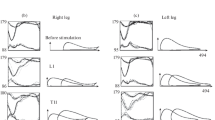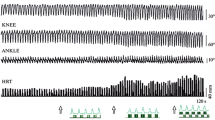Summary
We investigated the consequences of spinal cord transection in adult cats. All became capable of stepping upon a treadmill. Two of six animals stepped in the first postoperative testing session, 1 week after surgery. It took up to 6 weeks for the others to start stepping.
None of the cats became capable of hindquarter support within 2 months after surgery. There was permanent loss of fore-hindlimb coordination and increased variability in the duration of each step cycle and its components. Coordination between the hindlimbs was also impaired, as signaled by increased variability in the time between foot contacts with the belt. These changes may be due to the loss of timing signals coming down from supraspinal levels to the segmental step generators or — alternatively — to decreased excitability of segmental motoneurons leading to less precise execution of stepping commands from the hypothetical pattern generators.
Similar content being viewed by others
References
Arshavsky YI, Kots YM, Orlovsky GN, Rodionov IM, Shik ML (1965) Investigation of the biomechanics of running by the dog. Biophysics (USSR) 10: 737–746
Brown TG (1914) On the nature of the fundamental activity of the nervous centres, together with an analysis of the conditioning of the rhythmic activity in progression, and a theory of the evolution of function of the nervous system. J Physiol (Lond) 48: 18–46
Coss L, Chan AK, Goslow GE, Rasmussen S (1978) Ipsilateral limb variation in cats during overground locomotion. Brain Behav Evol 15: 85–93
Eidelberg E, Stein DG (1974) Functional recovery after lesions of the nervous system. Neurosci Res Program Bull 12: 191–303
Eidelberg E, Straehley D, Erspamer R, Watkins CJ (1977) Relationship between residual hindlimb-assisted locomotion and surviving axons after incomplete spinal cord injuries. Exp Neurol 56: 312–322
English AW (1979) Interlimb coordination during stepping in the cat: An electromyographic analysis. J Neurophysiol 42: 229–243
Forssberg H, Grillner S, Sjöström A (1974) Tactile placing reactions in chronic spinal kittens. Acta Physiol Scand 92: 114–120
Forssberg H, Grillner S, Rossignol S (1975) Phase-dependent reflex reversal during walking in chronic spinal cats. Brain Res 85: 103–107
Freusberg A (1874) Reflexbewegungen beim Hunde. Pfluegers Arch 9: 358–391
Goslow GE, Jr, Reinking RM, Stuart DG (1973) The cat step cycle: Hindlimb joint angles and muscle lengths during unrestrained locomotion. J Morphol 141: 1–14
Grillner S (1973) Locomotion in the spinal cat. In: Stein RB, Pearson KG, Smith RS, Redford JB (eds) Control of posture and locomotion. Plenum Press, New York, pp 515–535
Grillner S (1975) Locomotion in Vertebrates. Central mechanisms and reflex interactions. Physiol Rev 55: 247–304
Grillner S, Rossignol S (1978) On the initiation of the swing phase of locomotion in chronic spinal cats. Brain Res 146: 269–277
Grillner S, Zangger P (1979) On the central generation of locomotion in the low spinal cat. Exp Brain Res 34: 241–261
Hart BL (1971) Facilitation by strychnine of reflex walking in spinal dogs. Physiol Behav 6: 627–628
Hildebrand M (1959) Motions of the running cheetah and horse. J Mammal 40: 481–495
Hinsey JC, Cutting CC (1936) Reflexes in the spinal opossum. J Comp Neurol 64: 375–388
Kulagin AS, Shik ML (1970) Interaction of symmetrical limbs during controlled locomotion. Biophysics (USSR) 15: 171–178
Mesulam MM (1978) Tetramethyl-benzidine for horseradish peroxidase neurohistochemistry. J Histochem Cytochem 26: 107–117
Miller S, van der Meché FGA (1976) Coordinated stepping of all four limbs in the high spinal cat. Brain Res 109: 395–398
Miller S, van der Burg J, van der Meché FGA (1975) Locomotion in the cat: Basic programmes of movement. Brain Res 91: 239–253
Philippson M (1905) L'autonomie et la centralisation dans le système nerveux des animaux. Trav Lab Physiol Int Solvay Bruxelles, 7: 1–208
Ranson SW, Hinsey JC (1930) Reflexes in the hindlimbs of cats after transection of the spinal cord at various levels. Am J Physiol 94: 471–495
Shik ML, Orlovsky GN (1965) Coordination of the limbs during running of the dog. Biophysics (USSR) 10: 1148–1159
Shurrager PS, Dykman RA (1951) Walking spinal carnivores. J Comp Physiol Psychol 44: 252–262
Snedecor GW, Cochran WG (1967) Statistical methods, 6th edn. Iowa University Press, Iowa City, pp 172–178
Wetzel MC, Atwater AE, Wait JV, Stuart DG (1976) Neural implications of different profiles between treadmill and overground locomotion timings in cats. J Neurophysiol 38: 492–501
Wetzel MC, Stuart DG (1976) Ensemble characteristics of cat locomotion and its neural control. Prog Neurobiol 7: 1–98
Author information
Authors and Affiliations
Additional information
Supported in part by grants from the NINCDS (NS-14546) and the Paraplegia Foundation of Arizona
Medical Investigator of the Veterans Administration
Rights and permissions
About this article
Cite this article
Eidelberg, E., Story, J.L., Meyer, B.L. et al. Stepping by chronic spinal cats. Exp Brain Res 40, 241–246 (1980). https://doi.org/10.1007/BF00237787
Received:
Issue Date:
DOI: https://doi.org/10.1007/BF00237787




